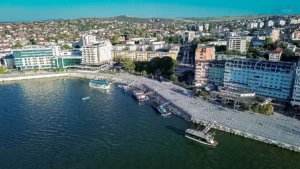
Greylag goose

Description and how to observe Greylag goose:
The Greylag goose, also known as the common goose, is a medium to large-sized bird, weighing between 3 and 4.5kg. The plumage is predominantly grey with lighter shades on the underside and a distinctive white throat. Summer geese also have an orange beak and legs of the same colour.
To observe these birds in the Danube Delta, visitors should head for freshwater areas, lakes or marshes, where they feed and gather in groups. The best times to watch are mornings and evenings, when the birds are most active.
What it feeds on Greylag goose:
Greylag geese are herbivorous, feeding mainly on grasses, leaves, seeds and other aquatic plants. These birds use their beaks to penetrate the soil to find roots or tubers. They may also eat grains, attracted to agricultural fields near their natural habitats.
Threats:
Threats to Greylag geese include habitat loss due to human activities such as construction and intensive agriculture. Water pollution and illegal hunting are also significant risks. Climate change also affects migration and breeding.
Ecological role:
More information about Anser anser:
The Danube Delta is one of Europe's most important wetlands and a UNESCO World Heritage Site. It is a crucial habitat for many bird species, including the summer goose. Visitors can explore this biodiversity through eco-tourism tours, observing not only the geese, but also other bird and wildlife species living in this unique ecosystem.
Discover now the most beautiful places in the Danube Delta!
In the following pages, you will find detailed information about:
- Top tourist destinations: Traditional villages, nature reserves, tourist trails and much more.
- Activities and attractions: Everything you need to know about boating, fishing, bird watching, cycling and other activities.
- Accommodation and catering: Accommodation to suit all budgets and restaurants serving traditional cuisine.




